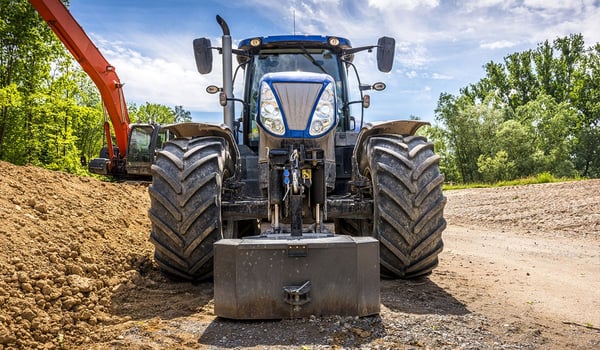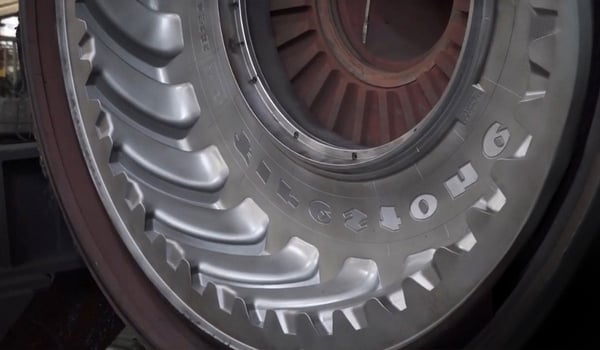BRIDGESTONE EUROPE NV/SA
AG Department
Kleine Kloosterstraat 10
1932 Zaventem
Belgium
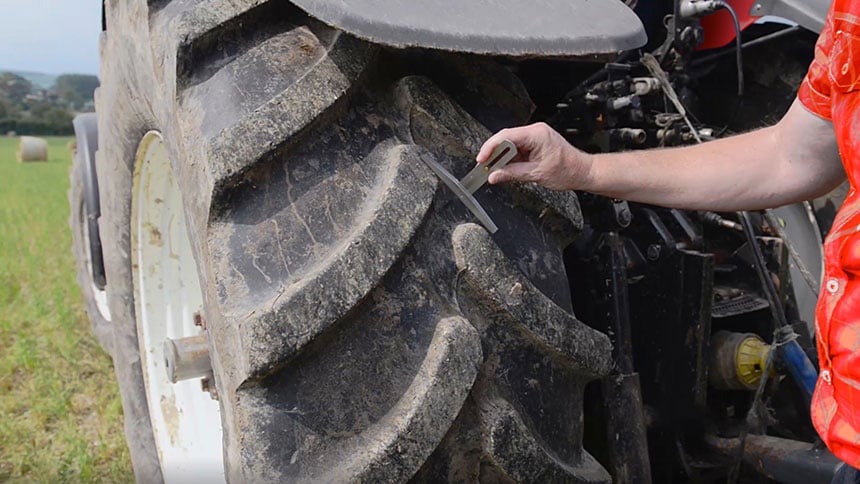
Authored by: Tractor tyre expert | 28 August 2021
Wear is generally the main reason for having to change your agricultural tyres, which represents a considerable cost for your farm.
Just like all parts that wear, the speed at which your tyres deteriorate depends on their level of quality, but also and above all on your use of them: rare or frequent, on hard ground, in the fields, on the road, etc.
By following a certain number of basic rules, you can slow down wear and put off replacing your tractor tyres for longer.
There is no average pressure at which you can do everything, carry excessive loads, drive fast, not take account of the type of ground, etc.
Many farmers tend to increase the inflation pressure in their tyres as a precaution, to avoid having to check tyre pressure based on load in order to save time.
Even though overinflation may help reduce the crushing of the tyres, it can lead to premature wear in certain conditions.
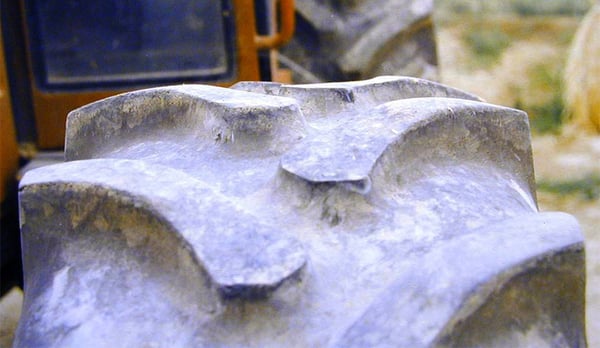 Wear linked to overinflation and use on the road
Wear linked to overinflation and use on the road
Practically speaking, an overinflated tyre is more rigid, which is more suitable for the road. In the fields, it will have a reduced contact patch with the ground, which will reduce its traction capacity and is likely to increase rolling resistance, the risk of slippage and compression leading to soil compaction: In the long term, this will considerably reduce the production capacity.
There are different drawbacks to driving with under inflated tyres, but this may also lead to excessive wear.
Opting for a pressure of up to 0.4 bar less than the manufacturer recommendations to avoid soil compaction can also cause wear to the tyre. If you choose to do this, you must imperatively establish the overall payload and adapt travelling speed accordingly.
Ideally, you should adjust inflation pressure based on the load, the working area and the type of ground.
During harvesting and silage periods, agricultural tyres are placed under a great deal of strain and will wear rapidly. They effectively have to bear heavy loads, in particular the weight of the tractor, the different implements or trailers and the fruit of the harvest.
This type of load increases the strain placed on the tread and the casing of the tyres, which, in the long term, may lead to permanent deformation.
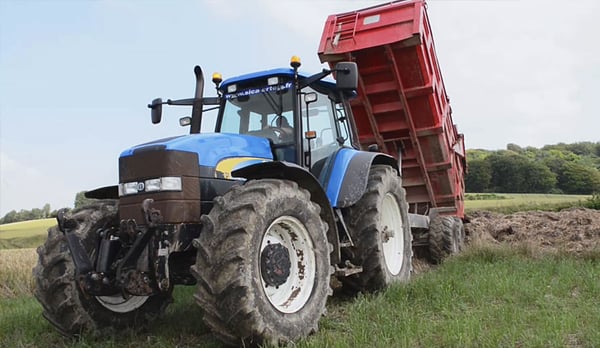
If you use a trailer with several axles, make sure that the harvest is well distributed in the tipper so that the load is evenly spread over the different axles.
This will make the tyre wear even and increase the lifespan.
It is crucial, when buying, to choose the right tyres. To avoid premature wear and guarantee your tyres’ resistance, make sure that your tyre size and load index correspond to your maximum loads including implements and trailers.
In any case, try not to overload your tyres by reducing the quantities transported whenever possible.
When your right tyres wear faster than your left tyres, or the other way around, you can swap them over, on condition that this is not caused by a mechanical problem (misalignment or mounting error).
Swapping your tyres around may be an interesting way to optimise wear over a longer period of time. This is particularly useful for the front wheels of a tractor.
Although quality agricultural tyres are made to cope with extreme conditions on the road and in the fields, they do have a limited lifespan.
In addition to pressure and load, their lifespan also depends on the speed at which they travel.
Speed has a major influence on wear, which is directly linked to the resistance of your tyre’s rubber.
If you want to use your tyres for longer, the best advice we can give you is to:
To have a good understanding of this speed index, you simply need to refer to the manufacturer’s speed rating chart supplied with your equipment upon purchase.
By driving too frequently at a higher speed than recommended by the manufacturer, you could rapidly damage the layer of rubber which makes up your tyre’s tread.
This wear will be even more rapid if you drive too fast on the road with a heavy load.
Speed associated with compression caused by the load effectively leads to overheating of the internal structure of the tyre, with temperatures potentially reaching 60 degrees or more. It is therefore highly advisable to reduce speed to limit heating and the deterioration of your casing.
LGeometry problems are among the most frequent causes of agricultural tyre wear. This type of problem is linked to the different types of strain imposed on your tyres during use.
The angle settings to be checked are:
Parallelism corresponds to the angle between the axis of the wheel and the direction of travel. Ideally, your tyres should be perfectly parallel to the tractor, otherwise you could wear the exterior of the tyre rapidly (toe-in) or the interior (toe-out).
A maximum toe-out angle of 1 to 1.5 mm is recommended, in order to offset the mechanical strain linked to the tractive force sustained by the front axle when in four-wheel drive.
Camber is the tilt of the wheels compared to a vertical position. When you adjust camber, your wheels should be as flat as possible on the ground to avoid damaging them rapidly.
The lead ratio is the number of rotations the smaller front tyres make in relation to the larger rear tyres on four-wheel drive tractors.
It enables the synchronisation of the front and rear axles of the tractor.
It has to be correct to avoid your tyres wearing rapidly, given that an incorrect lead ratio results in premature wear to the two front tyres compared to the rear tyres or the other way around.
The wrong lead ratio also results in wear to the mechanical parts.
To keep your tyres longer, you must choose a tyre size that ensures the right amount of lead so that the tractive force is slightly higher at the front than at the rear, with the front axle pulling slightly more.
Among the different factors which could lead to the premature wear of your agricultural tyres, your daily use is decisive.
If you have chosen low-pressure tyres designed for work in the fields and you use them in a quarry or forest area, this will considerably accelerate the rate of wear in addition to the risk of even bigger problems. You must not consider the tyres’ robustness as a guarantee that they will withstand all possible uses.
Unlike car or motorbike tyres, agricultural tyres are not designed for the road, but principally for use in the fields. Unfortunately, farms have plots of land that are increasingly far away, which means that tractors are obliged to make long trips by road to reach the fields or transport harvests.
Several factors may lead to rapid wear to your tyres when you drive on the road:
This is also one of the frequent causes of wear to your agricultural tyres. Agricultural tyres are effectively not designed to withstand difficult working conditions in the forest.
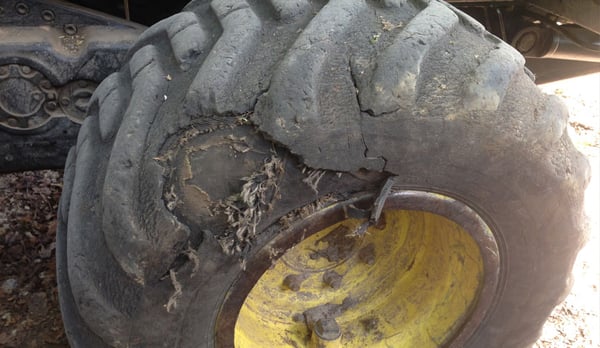 Wear linked to hard surface forest clearing operations
Wear linked to hard surface forest clearing operations
If you need to collect wood or carry out forest clearing operations, you should use forestry tyres that are suitable for this purpose and which were designed to withstand sharp stones, pointed branches and tree stumps, etc.
Try to avoid excessive on-the-spot manoeuvres, because this will rapidly damage the rubber of your tyres.
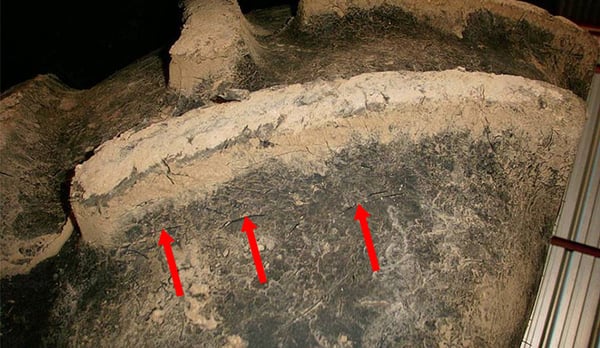
Repeated turning circles on concrete with a front loader to load the trailers or store fodder could lead to breaks at the lug base, making the tyre rapidly unfit for use.
Most people who read this article have also read some of the following articles:
